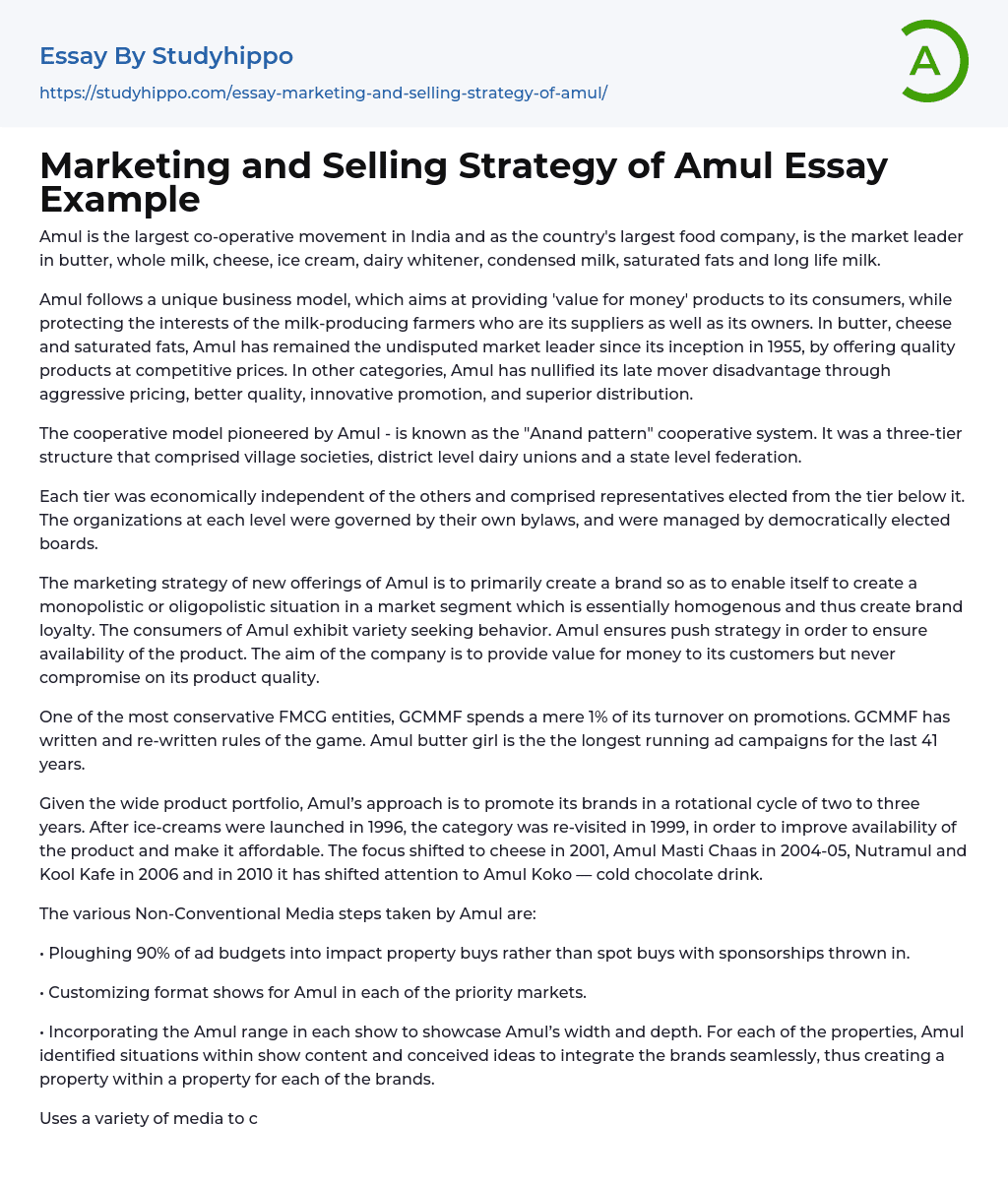Amul is the biggest cooperative movement and market leader in India for a variety of dairy products including butter, whole milk, cheese, ice cream, dairy whitener, condensed milk, saturated fats, and long life milk.
Amul has a unique business strategy that centers around providing cost-effective products to customers and supporting the farmers who both supply its milk and have ownership in the company. Since its inception in 1955, Amul has been the market leader for butter, cheese, and saturated fats through their commitment to delivering top-notch items at competitive costs. In other product categories, Amul has overcome its initial disadvantage as a latecomer by utilizing aggressive pricing, guaranteeing exceptional quality, implementing innovative promotional tactics, and establishing efficient distribution networks.
The Amul cooperative model, also known as the "Anand pattern" cooperative s
...ystem, consisted of village societies, district level dairy unions, and a state level federation.
Each tier operated independently from the others in terms of economics and featured representatives elected from the tier below it. Each level had its own bylaws and was overseen by democratically elected boards.
The primary goal of Amul's marketing strategy for its new offerings is to establish a strong brand presence, aiming for a monopolistic or oligopolistic position in a homogenous market segment. This approach aims to create brand loyalty among Amul's consumers who are known for their variety seeking behavior. Alongside, Amul adopts a push strategy to ensure widespread availability of its products. The company's objective is to provide customers with value for money while never compromising on product quality.
GCMMF, a highly conservative FMCG company, devotes just 1% of its turnover to
promotions and has revolutionized the industry. Remarkably, GCMMF has consistently maintained the longest running ad campaign featuring the Amul butter girl for an impressive 41 years.
Amul promotes its brands in a rotational cycle of two to three years due to its wide product portfolio. In 1999, they re-visited the ice-cream category to enhance availability and affordability. The focus then shifted to cheese in 2001, Amul Masti Chaas in 2004-05, Nutramul and Kool Kafe in 2006. Currently, Amul is focusing on Amul Koko, a cold chocolate drink launched in 2010.
Amul has implemented a range of Non-Conventional Media initiatives.
• Allocating 90% of advertising budgets to impact property purchases, rather than spot buys with included sponsorships.
• The format shows for Amul in each of the priority markets are customized.
Amul's range was incorporated into each show to demonstrate the breadth and depth of their products. For each show, Amul found ways to seamlessly integrate their brands into the content, creating a unique brand presence for each one.
Utilizes different forms of media to convey a desired message, with the most well-known being the billboard campaign. The charming girl dressed in polka dots and clever wordplay on diverse subjects further grows the brand's number of loyal supporters.
Other promotional activities consist of the Amul food festival (held in 50,000 retail outlets), The Chef Of India contest, Amul Maharani contest, Singing Competition AMUL Star Voice of India, and Amul Music Ka Maha Mukabla.
Amul aims to transition consumer behavior from focusing on search attributes to credence attributes and ultimately adopt heuristics.
Nevertheless, the company's marketing plans mention
particular conflicts.
• Ownership of assets: In the past, the company would lease cooling equipment to retailers. However, when the company attempted to retrieve the equipment, the retailer refused to comply and contested ownership.
The company faces difficulties with stocking issues in their leased fridges as retailers frequently stock the competing brand, which is challenging to control.
The company's failure to replace deteriorating products is a significant vertical conflict issue.
The company's credit policy, particularly for institutional sales, has a shorter credit period compared to the market, which is highly significant.
The quality of packaging is demanded by channel members for easy storing.
• Amul cheese and all hard selling items experience delayed replenishment of stocks.
• The Company offers lower margins to all channel members, such as retailers, compared to Britannia. For instance, the retailer's margin for butter is 8% while Britannia offers 12%.
- Wal-Mart essays
- Discover essays
- Competition essays
- Effective Leadership essays
- Leadership Styles essays
- Public relations essays
- Planning essays
- Mission Statement essays
- Outsourcing essays
- Swot Analysis essays
- Business Analysis essays
- Business Plan essays
- Strategic Management essays
- Strategic Planning essays
- Reasoning essays
- Community Development essays
- Negotiation essays
- Advertisement essays
- Advertising essays
- Anheuser-busch essays
- Audience Theory essays
- Brand essays
- Brands essays
- Competitor Analysis essays
- Consumer essays
- Detergent essays
- Marketing Management essays
- Marketing Mix essays
- Marketing Plan essays
- Marketing Research essays
- Marketing Strategy essays
- New Product Development essays
- Point Of Sale essays
- Price essays
- Procurement essays
- Product essays
- Product Differentiation essays
- Product Placement essays
- Promotion essays
- Promotion And Marketing Communications essays
- Research Design essays
- Retailing essays
- Trademark essays
- Accounting essays
- Andrew Carnegie essays
- Automation essays
- Business Cycle essays
- Business Intelligence essays
- Business Model essays
- Business Operations essays




